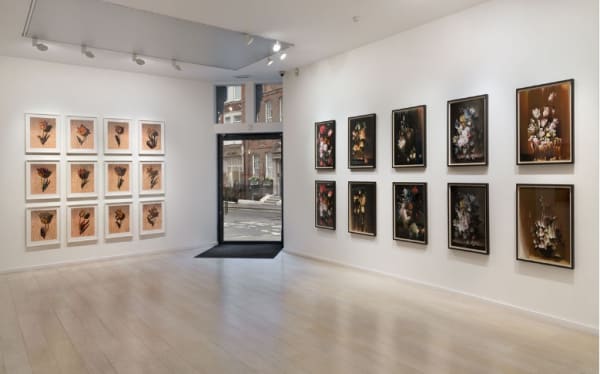Gordon Cheung
Breaking Tulips, an exhibition of new work by Gordon Cheung, provides an historical reflection of contemporary culture through the exploration of the Dutch Golden Age, a period of extraordinary wealth and power in 16th- and 17th- century Holland. 'Tulipmania' was the world's first recorded major financial crash, and is also the title of a series of twelve hand painted prints by Cheung. Tulipmania 1 - 12 will be shown alongside a number of other works including prints based on Dutch 17th-century still lifes from the Rijksmuseum, together forming an exciting body of work which seeks to highlight that economic bubbles are not a modern-day phenomenon.
'Tulipmania' was a notorious episode in 17th-century Dutch history, in which the trading of tulip bulbs became so extreme that the price of one flower would sell for ten times the annual wage of a skilled worker. Breaking Tulips refers to the then unknown plant virus that caused tulips to blossom with desirable stripes, making them exceptionally rare and valuable to tulip speculators almost 400 years ago. Based on original watercolours of tulips from speculators catalogues, Cheung depicts a single tulip on a layer of collaged stock listings newsprint from the 'Financial Times'; these columns of data provide evidence of the complex digital networks that connect countless physical locations around the world in our wealth-obsessed era. Cheung relates this event to contemporary thinking, commenting, "In the context of the Dutch Golden Age the Tulip Breaking virus is both a biological and mind virus where a distorted sense of economic value has taken hold in a herd mentality."
Cheung continues his negotiation between the past and present via openly sourced images of Dutch 17th-century still life paintings from the Rijksmuseum, Amsterdam. Using images of works by artists such as, Jacob van Walscapelle, Rachel Ruysch, Jan Davidsz de Heem and Hans Bollongier, Cheung disrupts the depicted still life so that it appears to melt down before our eyes.
"By using still life paintings from the Rijksmuseum and 'glitching' them with Kim Asendorf's open source algorithm, I splice together a hybrid that compresses the past and suggests the transient repetition of history. The visual effect of the 'glitching'is to dissolve the paintings into virtual sand like effects. Nature seems caught in digital quick sands of pixels."
Entitled New Order and Small New Order, these works will be shown alongside six hand-painted still life prints, named after the opening lines of Auguries of Innocence, a poem by 19th-century poet and artist William Blake (1757 - 1827), which uses apocalyptic imagery to warn society of the consequences of injustice and corruption.
Cheung's art looks to the future, whilst remaining firmly rooted in the past; reminding us that recent dot.com and millennial frenzies and the boom and busts of housing markets are not modern occur-rences. However, today we have adapted to a matrix of technologies that have electronically merged to create a virtual landscape. Our technology-driven era has disrupted our notions and perceptions of time and distance so that we now exist in a state of constant flux.
The exhibition will be accompanied by a panel discussion and a fully illustrated catalogue, with an introductory essay by art historian, writer and broadcaster Charlotte Mullins.
The Alan Cristea Gallery is the exclusive worldwide representative for Gordon Cheung's original prints.






